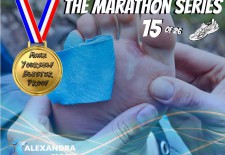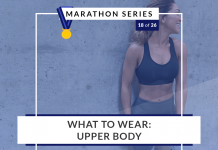Last updated on July 25th, 2022 at 12:40 pm
Whilst you may have visions of the perfect marathon, mother nature normally has her own plans! So making sure you are prepared for all types of weather is the best approach.
Of course checking the weather the night before is a sensible idea, but still make sure you have kit for all conditions regardless, because even the met office gets it wrong sometimes. You can keep the kit you are less likely to need in your car or with a friend on the day, but as they say it’s better to have it and not need it, than to need it and not have it!
So what kit do you need? Well here is our recommended ideal kit lists for whatever the weather:
Ideal Weather (Cool and Dry)
The following items should form your “foundation” marathon kitlist, then add to it or swap out depending on what other conditions you are facing.
- Biomechanically fitted running shoes
- Running socks
- Good quality breathable shorts
- Technical sports underwear (including professionally fitted bra for the ladies)
- Ultralight packable shell jacket (for warming up)
- Breathable moisture wicking T-shirt (avoid cotton!!)
- Running lube and/or nip guards
- Running belt
- Gels (at least 4)
- Sports sweets (for pre run sugar hit)
- Running bottle
Wet Weather
On a marathon in wet weather you have to face the fact you are going to get wet, it’s all about making things as comfortable as possible for the run.
- Cheap large bin liner – make a hole in the bottom for your head and use it to cover your torso during the warm up and waiting around at the start. Best not to run too far in it though otherwise you’ll get wet from the sweat building up on the inside.
- Spare dry comfy clothing – leave with a friend at the finish line or in your car to change into when you finish. Hoodies and tracksuit bottoms are perfect as they’ll make you feel better; don’t forget a nice thick pair of socks and dry trainers.
- Darker colours – Remember lighter colours become see-through when wet, so unless you want to look like you’re entering a wet t-shirt competition then aim for darker colours.
- Peaked running cap or visor – this will help keep the driving rain out of your eyes and will therefore make visibility much better.
- A spare dry T-shirt – if you can get a friend to pass you this at around the 22 mile mark it will make the hardest section of the run a bit more bearable.
- Running sunglasses – preferably with a light tint will ensure that you won’t get rain in your eyes; however some runners complain that between the fogging and having to wipe the lenses you’re better without.
- Water-resistant or Gore-Tex lined footwear – There is nothing more annoying than running and getting wet feet! that irritating squelch and then the onslaught of blisters from the increased friction. A pair of GTX shoes and moisture wicking socks will help prevent these issues.
Cold Weather
Cold weather alone isn’t as bad as it may seem, unless of course it’s also windy, raining or snowing!
- Layers – The most important principle of exercising in the cold is to ensure you can jettison layers as your body heats up, get some cheap outer layers from a charity shop so you can ditch them on the run (most marathons will pick up abandoned clothes and take them to a charity shop).
- Good running gloves – Very important as cold hands become painful and could eventually stop you from running!
- Breathable Hat – Not a knitted beanie! Look for a specific running hat that will be highly breathable and moisture wicking to remove sweat from your head.
- Running Tights – Not all runners like them, but if you are more susceptible to the cold then they are awesome, if you get compression tights then they can also help with blood flow and reduce lactic acid build up.
- Buff – a highly versatile piece of kit that can protect your neck, head, ears, chin and nose from the cold, depending how you wear it.

Windy Weather
Be prepared for the windchill factor, which is as a result of fresh air continually robbing heat from your body as it moves past you.
- Windproof Jacket – Ideally a running specific jacket as it will be more breathable and lighter than any other windproof jacket, this will keep the chill off you and actually make you more aerodynamic as it deflects the wind.
- Running Tights – Again love them or hate them, tights will reduce your drag and make it easier in wind, they will also offer some protection from windchill.
- Headband – Headbands or as some call them, ear warmers, are a great choice if you have longer hair. They will stop your ears getting painfully cold and also they can hold your hair in place better to again reduce drag.
This should help to prepare you for most sorts of weather you’ll find in the UK, however if you want advice on any other types of conditions then why not drop us an email?
Here is the next blog article in our marathon series:









